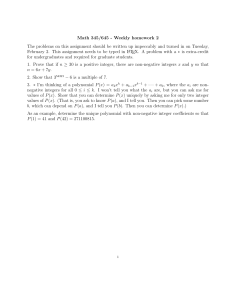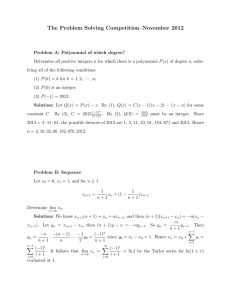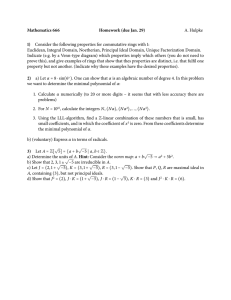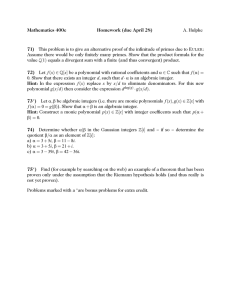ProjectSpecification.doc
advertisement
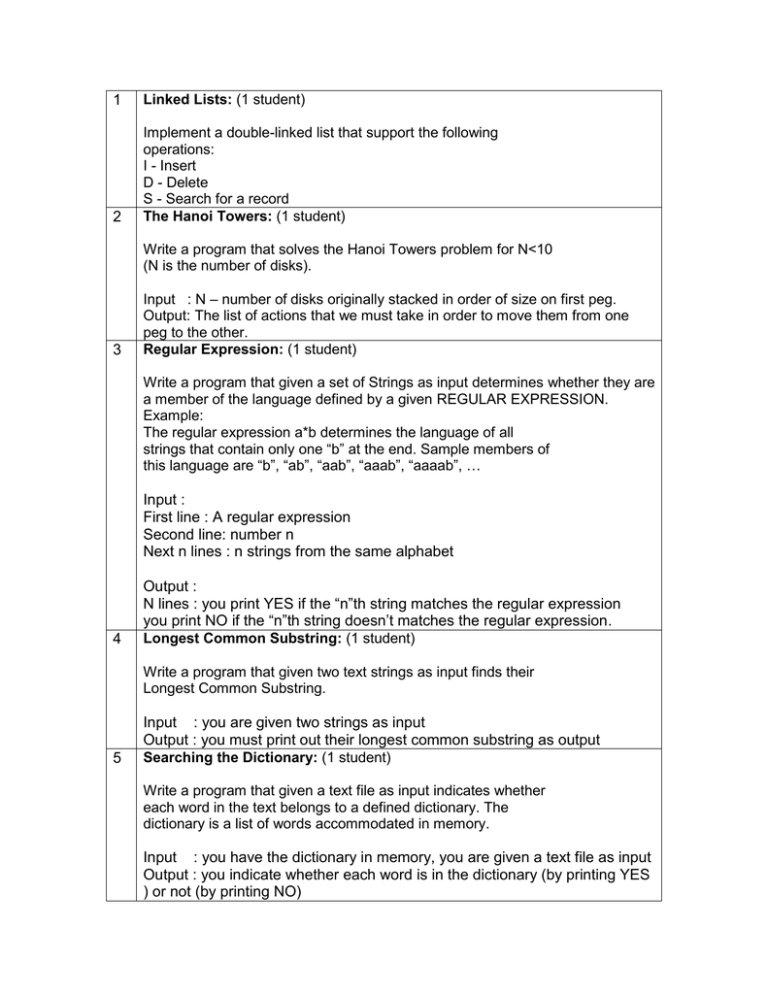
1 Linked Lists: (1 student) 2 Implement a double-linked list that support the following operations: I - Insert D - Delete S - Search for a record The Hanoi Towers: (1 student) Write a program that solves the Hanoi Towers problem for N<10 (N is the number of disks). 3 Input : N – number of disks originally stacked in order of size on first peg. Output: The list of actions that we must take in order to move them from one peg to the other. Regular Expression: (1 student) Write a program that given a set of Strings as input determines whether they are a member of the language defined by a given REGULAR EXPRESSION. Example: The regular expression a*b determines the language of all strings that contain only one “b” at the end. Sample members of this language are “b”, “ab”, “aab”, “aaab”, “aaaab”, … Input : First line : A regular expression Second line: number n Next n lines : n strings from the same alphabet 4 Output : N lines : you print YES if the “n”th string matches the regular expression you print NO if the “n”th string doesn’t matches the regular expression. Longest Common Substring: (1 student) Write a program that given two text strings as input finds their Longest Common Substring. 5 Input : you are given two strings as input Output : you must print out their longest common substring as output Searching the Dictionary: (1 student) Write a program that given a text file as input indicates whether each word in the text belongs to a defined dictionary. The dictionary is a list of words accommodated in memory. Input : you have the dictionary in memory, you are given a text file as input Output : you indicate whether each word is in the dictionary (by printing YES ) or not (by printing NO) 6 In-place Word Reverser: (1 student) Write a program that reverses every word in a text file. The operation must be done IN PLACE which means the words shall remain in their original position in the file. 7 Input : you are given a text file as input Output : the output is a text file that has all the words of the input file but they are all reversed. Painter: (2 students) Write a program that takes a bitmap file as input and performs the following operations on it upon request by the user: c- draws a circle s- draws a square l- draws a line 8 Input : you take a bmp file as input, and a set of instructions Output : the modified bmp file Exam Scheduling: (3 students) It’s the end of the term and final exams are about to be held. There are several courses with different number of students and a number of rooms with different number of chairs. Some students have registered in more than one course so their exams can not overlap. It’s your job to come up with a schedule for the finals so that every one can take their exams.(This could be a one day or N day schedule) Input : first line number of the final exams to be scheduled N In the next N lines the duration and number of students of each exam is given by two integers separated with a space. The next line has integer M as the number of available classes. The next M lines have the capacity of the “i”th class.(0<i<M+1) The last line has integer P as the number of days you have for setting up finals. 9 Output: for each class output their schedule for the coming P days. Elevator Scheduling: (3 students) We have three separate elevators in a building, each of them have their own keypad and they can hold 10 people at the time. Your job is to implement an assembly program that manages and responds to the requests of the residents of the building. You should implement the appropriate Interrupt Handlers in this project. Input: N is the total number of requests made to the elevators. The next N-lines have the following information separated by space. -The number of the elevator to which the request is made -the time of the request -the direction of the request(up/down) -number of passengers who want to get in -the floor they are in -the floor they want to go to Output : for each elevator print out its schedule 10 Printer Spooler: (3 students) You should implement Printer Scheduler which receives the requests for prints from different components of the operating system and manages them (puts them in a queue) in accordance to their size and priority. Input: in the first line there are numbers M and N respectively where M is the number of operating system components and N is the number of requests made to the printer. In the next N-lines the following information is provided and separated by spaces: - an integer indicating the number of the component that sends the request an integer indicating the priority of the job(lower numbers represent higher priorities) an integer indicating the minute length of the job output: you must schedule the printer so that all the jobs are processed in two ways: - by their priority - minimizing the total waiting time 11 Packet Switching: (3 students) You must implement a program that handles the packet switching program in a network station which has several in/out ports. We have a switch or router. Each packet has a source and destination port. At each second any number of packet could come in and go out of any of the ports.You have a buffer with definite size; it’s your job to program the switch so that it can handle packets. Example: At time slot 0, you have two packets from ports 1 and 4 which both want to go to port 2. It’s your job to decide in what order they should line up. (According to their importance and size). 12 Alarm: (2 students) You have to implement a personal alarm. The personal alarm must be able to signal at the specified time. It must be able to sort and store the events in your agenda. 13 Huffman Code: (3 students) Write a program that takes an input file in text format and produces the Huffman Code for it. Output the text coded by the Huffman Algorithm. 14 LCM and GCD: (2 students) Write a program that given two integers calculates their greatest common divisor and their Least Common Multiple. 15 Euclidean Algorithm: (2 students) Implement it in both Iterative and Recursive Methods. (For finding the GCD) 16 Multiplication of Polynomials: (2 students) Write a program which multiplies two polynomials. The polynomials are defined by reading the polynomial coefficients from the input. Note: Implementations with more efficient algorithms and better time order, receive higher grades. Input: first line are m integers defining x m ’s coefficients respectively. n Second line are n integers defining x ’s coefficients respectively. Output: their product as a polynomial with m+n integers defining the answers coefficients. 17 Prime Numbers Counter: (1 student) Write an assembly program which counts the number of 32 bit prime numbers. These prime numbers fall in the range of 21474836 and 424967295. Output: print out the prime numbers. 18 Random Number Generator: (2 student) Implement a generator for a sequence of random numbers. The range of the numbers will be determined every time the program starts its execution. (Maximum range is 65536). You will provide the number of sequence sentences and the seed (for generating a random number) as input to the program. Note that seed ¡ 0 means that Time of system will be used. Note: implementing different algorithms and comparing them is suggested. Input : N the number of random numbers that you have to generate Output: N random numbers 19 CRC: (1 student) Write a program that accepts n 8-bit characters, computes and displays their CRC (Cyclic Redundancy Code) using the following polynomial generator. G(X) = X5 + X3 + 1 Algorithm: A: XOR the next character with the G(x) B: Shift the result one bit right C: If last character is not reached, go to point A 20 My Birthday Book: (2 students) Write a program that sorts the given list of entries alphabetically in ascending or descending order. Each record of the list consists of two parts: Name and date of Birth. The program must support the following commands: f) Sort according to names l) Sort according to last names a) Sort in ascending order d) Sort in descending order q) Quit 21 Polyndrome: (1 student) Write a program that counts the number of Polyndromes (words that remain the same after being spelled backwards) in an input text file. Input: input text file Output: the number of polyndromes in the input. 22 Definite Integral Computation: (1 student) Write a program to compute the definite integral of a given polynomial function of a maximum order of 5. The polynomial is mdefined by reading its coefficients as input and integration interval. Use the different Numerical integration methods. 23 Traffic Light: (2 students) You must implement the traffic light scheduler for a set of crossroads. The map of the city and the density of cars on each way will be given to you. There are streets which only have one lane, but there are cars who want to pass from both sides. You must decide how they should do this. 24 Grey Code: (1 student) Implement a program that produces the Grey Code for a binary string. 25 6800 Animation Project: (3 students) The program Should support the following commands: a) Accepting an instruction b) Reporting Syntax Fault if any exists c) Generating Machine Code d) Showing the execution of the instructions graphically This project has to be implemented in C or C++ and can have extra credit if the program has high quality.
